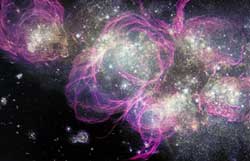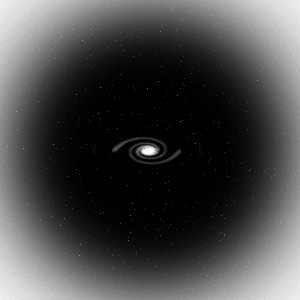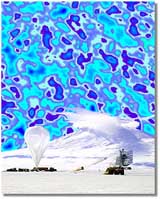
Era of Nuclei
Key points: First stars, assembly of galaxies, role of dark matter in galaxy growth

Era of Atoms
After recombination the concentrations could cool and attract more matter. For more, see http://background.uchicago.edu/~whu/physics/physics.html
 |
The simulation to the left shows how the matter was attracted into
large scale structures that are where galaxies eventually formed by Andrey Kravtsov (The University of Chicago) and Anatoly Klypin (New Mexico State University). Visualizations by Andrey Kravtsov. The one to the right shows more detail,
from National
Center for Supercomputer Applications (reload to restart text animations) |
 |
Exactly how this happened, we do not know -- but we know it did because we see galaxies in the Hubble Deep Field at about 1 billion years into the life of the Universe.

Era of Galaxies
The gap in time when matter in the Universe was converted from a nearly uniform distribution to its clumpy state at z = 6 is sometimes called the "dark ages" because we know so little (and because the cosmic background cooled to where we could not see it and stars had not yet formed in enough numbers to light it up). We have to leave it largely to theory to probe what might have happened.
| We believe that the stars, galaxies, and
planets formed in the gravitational wells in the early Universe. The artist's concept to the
right shows the Universe shortly after the first stars formed, when their photons are
exciting the gas around them and blowing huge bubbles into the surrounding gas.(From
NASA Origins Theme Roadmap, 2003; http://origins.jpl.nasa.gov/universe/invest02.html) This
animation lets you watch the bubble-like structures grow as the first stars ionize the
surrounding gas and change the very nature of the Universe
|
 |
 |
It shows the growth of structures due to the
dark matter gravity, then the first galaxies form and begin to merge as they collide with
each other. |
| And view this movie to watch a single galaxy form and grow |
 |
Dark matter places a critical role in the process of galaxy formation. Galaxies appear to have huge distributions of dark matter around the visible stars, as we see from their rotation curves (to be discussed later). These dark matter halos increase the effective size of the galaxy and make it far more likely to collide with other galaxies. Starting with small scraps of galaxies, it appears that large galaxies grow by collisions and mergers. (from Jose Wudka, http://phyun5.ucr.edu/~wudka/Physics7/Notes_www/node121.html) |
| Here is a succinct summary of what we have discussed, by one of the originators of our ideas about the nature of the Universe. | The evolution of the world may be compared to a display of fireworks that
has just ended: some few red wisps, ashes, and smoke. Standing on a cooled cinder, we see
the slow fading of the suns, and we try to recall the vanished brilliance of the origin of
the worlds. - G. Lemaitre |
How well do we understand the early stages of the Universe![]()
Cosmology was long in the domain of theology and philosophy because of a
lack of observational data, and perhaps with the incredible recent progress, it is now
acquiring the potential to re-acquire this role in a different way![]() . Nonetheless, shouldn't we be a bit humble about how far
we can understand these issues
. Nonetheless, shouldn't we be a bit humble about how far
we can understand these issues![]()
For more on these subjects, try http://archive.ncsa.uiuc.edu/Cyberia/Cosmos/CosmosCompHome.html
Test your understanding before going on![]()

The Boomerang experiment launch is shown under the map obtained of the sky. http://www.nsf.gov/od/lpa/news/02/fsballoon.htm |

Apollo, Greek god of the sun, http://www.forthnet.gr/olympics/athens1896/pictures/pics/apollo.jpg |
|
Click to return to syllabus |
||
| Click to return to the Era of Nuclei | hypertext |
Click to see about the Sun |